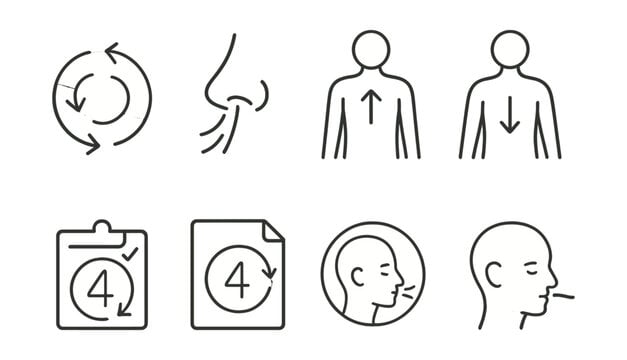BREATH COUNTING FOR ANXIETY REDUCTION
fitness Mindset Breathing Aug 11, 2025 7:14:57 AM Kyle Receno 6 min read

Breath counting is a simple, mindfulness-based breathing technique that helps reduce anxiety, calm the mind, and improve focus. By focusing on counting breaths, this practice anchors attention and interrupts anxious thought patterns. This blog explores the science behind breath counting, its benefits for anxiety reduction, and practical steps to incorporate it into your daily routine.
Why Breath Counting Reduces Anxiety
Anxiety often triggers a racing mind and heightened stress response, activating the sympathetic nervous system. Breath counting slows breathing, engages the parasympathetic nervous system, and lowers cortisol levels, promoting relaxation. The act of counting provides a focal point, reducing mental chatter and fostering a sense of calm.
Key Benefits:
- Anxiety Relief: Calms the mind and reduces stress hormones.
- Improved Focus: Enhances concentration by anchoring attention to the breath.
- Emotional Regulation: Helps manage overwhelming emotions.
- Better Sleep: Prepares the mind for restful sleep.
- Accessible Practice: Requires no equipment and can be done anywhere.
How Breath Counting Works
Breath counting involves silently counting each breath cycle (inhale and exhale) to maintain focus and slow the breathing rate. This activates the vagus nerve, which signals the body to relax, reducing heart rate and stress. The rhythmic counting also distracts from anxious thoughts, creating mental clarity and calm.
Step-by-Step Guide to Breath Counting
Follow these steps to practice breath counting effectively. Choose a quiet, comfortable space to begin.
- Find a Comfortable Position:
- Sit upright in a chair with feet flat or lie down with a straight spine.
- Rest hands on your lap or thighs to stay relaxed.
- Begin with Natural Breathing:
- Close your eyes (optional) and breathe naturally through your nose for a few moments.
- Notice the sensation of air entering and leaving your nostrils.
- Count Each Breath Cycle:
- Inhale deeply through your nose, then exhale slowly. Silently count “one” after the exhale.
- Repeat, counting “two” after the next exhale, up to “five.”
- After reaching five, start back at “one” and continue.
- Maintain Focus:
- If your mind wanders, gently return to counting without judgment.
- Continue for 5–10 minutes or 10–20 breath cycles.
Tip: If counting to five feels too fast, count to ten or extend each breath to 4–6 seconds for deeper relaxation.
Sample Breath Counting Routine (5–10 Minutes)
Incorporate this routine to reduce anxiety, ideally daily or as needed:
- Morning (5 Minutes): Practice upon waking to start the day calmly. Sit in a quiet space and count breaths to set a focused tone.
- Midday (3–5 Minutes): Use during a break to manage work or life stress. Practice at your desk or in a calm area.
- Evening (5–10 Minutes): Perform before bed to quiet the mind and improve sleep. Pair with dim lighting or a calming environment.
Tips for Success
- Practice Regularly: Aim for 5–10 minutes daily to build a habit and enhance benefits.
- Minimize Distractions: Find a quiet space and silence devices for better focus.
- Stay Patient: If thoughts intrude, gently redirect focus to counting without frustration.
- Combine with Relaxation: Pair with progressive muscle relaxation or visualization for deeper calm.
- Adjust Pace: Slow breaths if anxiety feels intense, aiming for 4–6 seconds per inhale/exhale.
Common Mistakes to Avoid
- Rushing Breaths: Keep breathing slow and natural to avoid hyperventilation.
- Overthinking Counts: Don’t worry about perfect counting; focus on the rhythm.
- Tensing Up: Relax shoulders, jaw, and face to maintain ease.
- Inconsistent Practice: Sporadic sessions reduce long-term anxiety relief.
Who Can Benefit?
Breath counting is ideal for:
- Anxiety Sufferers: Reduces acute and chronic stress symptoms.
- Professionals: Enhances focus during high-pressure tasks.
- Students: Improves concentration for studying or exams.
- Anyone: Promotes calm and mental clarity in daily life.
Additional Considerations
- Environment: Practice in a well-ventilated, quiet space to optimize focus and oxygen intake.
- Complementary Practices: Pair with mindfulness meditation or gentle yoga for enhanced relaxation.
- Health Precautions: Consult a doctor if you have respiratory or cardiovascular conditions or experience discomfort.
Conclusion
Breath counting is a simple, effective technique to reduce anxiety, improve focus, and promote calm. By practicing this mindful breathing method daily, you can quiet mental chatter, manage stress, and enhance emotional well-being. Start with the routine above and adjust to your needs for lasting benefits.
Disclaimer: Consult a healthcare professional if you have respiratory or medical conditions or experience discomfort during breath counting.
